Characteristics of NDVI Changes in the Altay Region from 1981 to 2018 and Their Relationship to Climatic Factors
Abstract
1. Introduction
2. Materials and Methods
2.1. Study Area
2.2. Data Collection and Processing
2.2.1. NDVI Dataset
2.2.2. Climate Dataset
2.2.3. Geomorphic and Vegetation Regionalization Data
2.2.4. The Digital Elevation Model (DEM)
2.3. Methods
3. Results
3.1. Interannual Variation in NDVI
3.2. NDVI ofterannual Trend in Geomorphic and Vegetation Types
3.3. Analysis of NDVI Abrupt-Change Year
3.4. Influence of Climatic Factors on NDVI Dynamic
4. Discussion
5. Conclusions
Author Contributions
Funding
Institutional Review Board Statement
Informed Consent Statement
Data Availability Statement
Acknowledgments
Conflicts of Interest
References
- Li, C.; Fu, B.; Wang, S.; Lindsay, C.S.; Wang, Y.; Li, Z.; Liu, Y.; Zhou, W. Drivers and impacts of changes in China’s drylands. Nat. Rev. Earth Environ. 2021, 2, 858–873. [Google Scholar] [CrossRef]
- Cao, D.; Zhang, J.; Xun, L.; Yang, S.; Wang, J.; Yao, F. Spatiotemporal variations of global terrestrial vegetation climate potential productivity under climate change. Sci. Total Environ. 2021, 770, 145320. [Google Scholar] [CrossRef]
- Griscom, B.W.; Adams, J.; Ellis, P.W.; Houghton, R.A.; Lomax, G.; Miteva, D.A.; Schlesinger, W.H.; Shoch, D.; Siikamaki, J.V.; Smith, P.; et al. Natural climate solutions. Proc. Natl. Acad. Sci. USA 2017, 114, 11645–11650. [Google Scholar] [CrossRef]
- Anderegg, W.R.L.; Wu, C.; Acil, N.; Carvalhais, N.; Pugh, T.A.M.; Sadler, J.P.; Seidl, R. A climate risk analysis of Earth’s forests in the 21st century. Science 2022, 377, 1099–1103. [Google Scholar] [CrossRef] [PubMed]
- Phiri, D.; Morgenroth, J.; Xu, C. Long-term land cover change in Zambia: An assessment of driving factors. Sci. Total Environ. 2019, 697, 134206. [Google Scholar] [CrossRef]
- Huang, K.; Xia, J.; Wang, Y.; Ahlström, A.; Chen, J.; Cook, R.B.; Cui, E.; Fang, Y.; Fisher, J.B.; Huntzinger, D.N.; et al. Enhanced peak growth of global vegetation and its key mechanisms. Nat. Ecol. Evol. 2018, 2, 1897–1905. [Google Scholar] [CrossRef] [PubMed]
- Wang, Q.; Zhai, P.; Qin, D. New perspectives on ‘warmingewetting’ trend in Xinjiang, China. Adv. Clim. Chang. Res. 2020, 11, 252–260. [Google Scholar] [CrossRef]
- Yuan, W.; Zheng, Y.; Piao, S.; Ciais, P.; Lombardozzi, D.; Wang, Y.; Ryu, Y.; Chen, G.; Dong, W.; Hu, Z.; et al. Increased atmospheric vapor pressure deficit reduces global vegetation growth. Sci. Adv. 2019, 5, eaax1396. [Google Scholar] [CrossRef] [PubMed]
- Tucker, C.J. Red and photographic infrared linear combinations for monitoring vegetation. Remote Sens. Environ. 1979, 8, 127–150. [Google Scholar] [CrossRef]
- Yuan, W.; Wu, S.-Y.; Hou, S.; Xu, Z.; Lu, H. Normalized Difference Vegetation Index-based assessment of climate change impact on vegetation growth in the humid-arid transition zone in northern China during 1982–2013. Int. J. Climatol. 2019, 39, 5583–5598. [Google Scholar] [CrossRef]
- Xu, Y.; Yang, Y.; Chen, X.; Liu, Y. Bibliometric Analysis of Global NDVI Research Trends from 1985 to 2021. Remote Sens. 2022, 14, 3967. [Google Scholar] [CrossRef]
- Yang, W.; Kogan, F.; Guo, W.; Chen, Y. A novel re-compositing approach to create continuous and consistent cross-sensor/cross-production global NDVI datasets. Int. J. Remote Sens. 2021, 42, 6023–6047. [Google Scholar] [CrossRef]
- Yang, J.; Xin, Z.; Huang, Y.; Liang, X. Multi-source remote sensing data shows a significant increase in vegetation on the Tibetan Plateau since 2000. Prog. Phys. Geogr. Earth Environ. 2023. [Google Scholar] [CrossRef]
- Liu, Y.; Li, Y.; Li, S.; Motesharrei, S. Spatial and Temporal Patterns of Global NDVI Trends: Correlations with Climate and Human Factors. Remote Sens. 2015, 7, 13233–13250. [Google Scholar] [CrossRef]
- Li, Z.; Chen, Y.; Li, W.; Deng, H.; Fang, G. Potential impacts of climate change on vegetation dynamics in Central Asia. J. Geophys. Res. Atmos. 2015, 120, 12345–12356. [Google Scholar] [CrossRef]
- Yao, J.; Chen, Y.; Zhao, Y.; Mao, W.; Xu, X.; Liu, Y.; Yang, Q. Response of vegetation NDVI to climatic extremes in the arid region of Central Asia: A case study in Xinjiang, China. Theor. Appl. Climatol. 2017, 131, 1503–1515. [Google Scholar] [CrossRef]
- Gouveia, C.M.; Trigo, R.M.; Beguería, S.; Vicente-Serrano, S.M. Drought impacts on vegetation activity in the Mediterranean region: An assessment using remote sensing data and multi-scale drought indicators. Glob. Planet. Chang. 2017, 151, 15–27. [Google Scholar] [CrossRef]
- Bao, G.; Bao, Y.; Sanjjava, A.; Qin, Z.; Zhou, Y.; Xu, G. NDVI-indicated long-term vegetation dynamics in Mongolia and their response to climate change at biome scale. Int. J. Climatol. 2015, 35, 4293–4306. [Google Scholar] [CrossRef]
- Li, L.; Zhu, L.; Xu, N.; Liang, Y.; Zhang, Z.; Liu, J.; Li, X. Climate Change and Diurnal Warming: Impacts on the Growth of Different Vegetation Types in the North–South Transition Zone of China. Land 2022, 12, 13. [Google Scholar] [CrossRef]
- Jiao, K.; Gao, J.; Wu, S. Climatic determinants impacting the distribution of greenness in China: Regional differentiation and spatial variability. Int. J. Biometeorol. 2019, 63, 523–533. [Google Scholar] [CrossRef]
- Jiao, K.-W.; Gao, J.-B.; Liu, Z.-H.; Wu, S.-H.; Fletcher, T.L. Revealing climatic impacts on the temporal and spatial variation in vegetation activity across China: Sensitivity and contribution. Adv. Clim. Chang. Res. 2021, 12, 409–420. [Google Scholar] [CrossRef]
- Wei, Y.; Sun, S.; Liang, D.; Jia, Z. Spatial–temporal variations of NDVI and its response to climate in China from 2001 to 2020. Int. J. Digit. Earth 2022, 15, 1463–1484. [Google Scholar] [CrossRef]
- Song, Y.; Ma, M. A statistical analysis of the relationship between climatic factors and the Normalized Difference Vegetation Index in China. Int. J. Remote Sens. 2011, 32, 3947–3965. [Google Scholar] [CrossRef]
- Yang, D.; Yi, G.H.; Zhang, T.B.; Li, J.J.; Qin, Y.B.; Wen, B.; Liu, Z.Y. Spatiotemporal variation and driving factors of growing season NDVI in the Tibetan Pla-teau, China. Ying Yong Sheng Tai Xue Bao 2021, 32, 1361–1372. [Google Scholar]
- Yu, H.; Bian, Z.; Mu, S.; Yuan, J.; Chen, F. Effects of Climate Change on Land Cover Change and Vegetation Dynamics in Xinjiang, China. Int. J. Environ. Res. Public Health 2020, 17, 4865. [Google Scholar] [CrossRef]
- Li, S.; Li, X.; He, Q.; Yi, L. Study on Climate Change in Altay Prefecture since Recent 40 Years. Arid. Zone Res. 2006, 23, 637–643. [Google Scholar]
- Zhang, Q.; Yang, J.; Wang, W.; Ma, P.; Lu, G.; Liu, X.; Yu, H.; Fang, F. Climatic Warming and Humidification in the Arid Region of Northwest China: Multi-Scale Characteristics and Impacts on Ecological Vegetation. J. Meteorol. Res. 2021, 35, 113–127. [Google Scholar] [CrossRef]
- Huang, H.; Xu, H.; Lin, T.; Xia, G. Spatio-temporal variation characteristics of NDVI and its response to climate change in the Altay region of Xinjiang from 2001 to 2020. Acta Ecol. Sin. 2022, 42, 2798–2809. [Google Scholar]
- Wang, B.; Cheng, W.; Song, K.; Wang, S.; Zhang, Y.; Li, H.; Deng, J.; Wang, R. Application of Ecology-Geomorphology Cognition Approach in Land Type Classification: A Case Study in the Altay Region. Sustainability 2022, 14, 4023–4045. [Google Scholar] [CrossRef]
- Xu, Y.; Yang, J.; Chen, Y. NDVI-based vegetation responses to climate change in an arid area of China. Theor. Appl. Climatol. 2016, 126, 213–222. [Google Scholar] [CrossRef]
- Meng, X.; Gao, X.; Li, S.; Lei, J. Spatial and Temporal Characteristics of Vegetation NDVI Changes and the Driving Forces in Mongolia during 1982–2015. Remote Sens. 2020, 12, 603. [Google Scholar] [CrossRef]
- Peng, S.; Chen, A.; Xu, L.; Cao, C.; Fang, J.; Myneni, R.B.; Pinzon, J.E.; Tucker, C.J.; Piao, S. Recent change of vegetation growth trend in China. Environ. Res. Lett. 2011, 6, 044027. [Google Scholar] [CrossRef]
- Verhoeve, S.L.; Keijzer, T.; Kaitila, R.; Wickama, J.; Sterk, G. Vegetation Resilience under Increasing Drought Conditions in Northern Tanzania. Remote Sens. 2021, 13, 4592. [Google Scholar] [CrossRef]
- Whetten, A.B.; Demler, H.J. Detection of Multidecadal Changes in Vegetation Dynamics and Association with Intra-Annual Climate Variability in the Columbia River Basin. Remote Sens. 2022, 14, 569. [Google Scholar] [CrossRef]
- Gorelick, N.; Hancher, M.; Dixon, M.; Ilyushchenko, S.; Thau, D.; Moore, R. Google Earth Engine: Planetary-scale geospatial analysis for everyone. Remote Sens. Environ. 2017, 202, 18–27. [Google Scholar] [CrossRef]
- He, J.; Yang, K.; Tang, W.; Lu, H.; Qin, J.; Chen, Y.; Li, X. The first high-resolution meteorological forcing dataset for land process studies over China. Sci. Data 2020, 7, 25. [Google Scholar] [CrossRef] [PubMed]
- Li, Y.; Qin, X.; Liu, Y.; Jin, Z.; Liu, J.; Wang, L.; Chen, J. Evaluation of Long-Term and High-Resolution Gridded Precipitation and Temperature Products in the Qilian Mountains, Qinghai–Tibet Plateau. Front. Environ. Sci. 2022, 10, 609. [Google Scholar] [CrossRef]
- Peng, Y.; Duan, A.; Hu, W.; Tang, B.; Li, X.; Yang, X. Observational constraint on the future projection of temperature in winter over the Tibetan Plateau in CMIP6 models. Environ. Res. Lett. 2022, 17, 034023. [Google Scholar] [CrossRef]
- He, P.; Sun, Z.; Han, Z.; Dong, Y.; Liu, H.; Meng, X.; Ma, J. Dynamic characteristics and driving factors of vegetation greenness under changing environments in Xinjiang, China. Environ. Sci. Pollut. Res. 2021, 28, 42516–42532. [Google Scholar] [CrossRef]
- Lu, B.; Brunsdon, C.; Charlton, M.; Harris, P. A response to ‘A comment on geographically weighted regression with parameter-specific distance metrics’. Int. J. Geogr. Inf. Sci. 2019, 33, 1300–1312. [Google Scholar] [CrossRef]
- Li, J.; Guan, J.; Han, W.; Tian, R.; Lu, B.; Yu, D.; Zheng, J. Important role of precipitation in controlling a more uniform spring phenology in the Qinba Mountains, China. Front. Plant Sci. 2023, 14, 1074405. [Google Scholar] [CrossRef] [PubMed]
- Lu, B.; Yang, W.; Ge, Y.; Harris, P. Improvements to the calibration of a geographically weighted regression with parameter-specific distance metrics and bandwidths. Comput. Environ. Urban Syst. 2018, 71, 41–57. [Google Scholar] [CrossRef]
- He, F.; Yang, F.; Zhao, C.; Li, S.; Li, M. Spatially explicit reconstruction of cropland cover for China over the past millennium. Sci. China Earth Sci. 2022, 66, 111–128. [Google Scholar] [CrossRef]
- Liu, Y.; Lyu, Y.; Bai, Y.; Zhang, B.; Tong, X. Vegetation Mapping for Regional Ecological Research and Management: A Case of the Loess Plateau in China. Chin. Geogr. Sci. 2020, 30, 410–426. [Google Scholar] [CrossRef]
- Roy, D.P.; Yan, L. Robust Landsat-based crop time series modelling. Remote Sens. Environ. 2020, 238, 110810. [Google Scholar] [CrossRef]
- Xing, X.; Yan, C.; Jia, Y.; Jia, H.; Lu, J.; Luo, G. An Effective High Spatiotemporal Resolution NDVI Fusion Model Based on Histogram Clustering. Remote Sens. 2020, 12, 3774. [Google Scholar] [CrossRef]
- Ma, J.; Liu, Y.; Sheng, J.; Li, N.; Wu, H.; Jia, H.; Sun, Z.; Cheng, J. Changes of relationships between dominant species and their relative biomass along elevational gradients in Xinjiang grasslands. Acta Prataculturae Sin. 2021, 30, 25–35. [Google Scholar]
- DelSole, T.; Tippett, M.K. A mutual information criterion with applications to canonical correlation analysis and graphical models. Stat. Int. Stat. Inst. 2021, 10, e385. [Google Scholar] [CrossRef]
- Su, R.; Cheng, J.; Chen, D.; Bai, Y.; Jin, H.; Chao, L.; Wang, Z.; Li, J. Effects of grazing on spatiotemporal variations in community structure and ecosystem function on the grasslands of Inner Mongolia, China. Sci. Rep. 2017, 7, 40. [Google Scholar] [CrossRef]
- DiMaso, E.N.T.; Bondi, R.W.; Guo, J.; O’Brien, A.G. A method for real time detection of reaction endpoints using a moving window t-test of in situ time course data. React. Chem. Eng. 2020, 5, 1642–1646. [Google Scholar] [CrossRef]
- Weng, C.H.; Luo, X.; Yang, W.; Liu, L.; Zhang, Y.; Weerasinghe, R. Spatial-Temporal variations of vegetation and the relationship with precipitation in summer-A case study in the hilly area of central Sichuan province. E3S Web Conf. 2018, 53, 03060. [Google Scholar] [CrossRef]
- Liu, Y.; Tian, J.; Liu, R.; Ding, L. Influences of Climate Change and Human Activities on NDVI Changes in China. Remote Sens. 2021, 13, 4326. [Google Scholar] [CrossRef]
- Xiong, Y.; Wang, H. Spatial relationships between NDVI and topographic factors at multiple scales in a watershed of the Minjiang River, China. Ecol. Inform. 2022, 69, 101617. [Google Scholar] [CrossRef]
- He, H.; Zhang, B.; Hou, Q.; Li, S.; Ma, B.; Ma, S. Variation Characteristic of NDVI and Its Response to Climate Change in Northern China From 1982 to 2015. J. Ecol. Rural Environ. 2020, 36, 70–80. [Google Scholar]
- Zhang, J.; Zhang, Y.; Sun, G.; Song, C.; Li, J.; Hao, L.; Liu, N. Climate Variability Masked Greening Effects on Water Yield in the Yangtze River Basin During 2001–2018. Water Resour. Res. 2022, 58, e2021WR030382. [Google Scholar] [CrossRef]
- Du, J.; Fang, S.; Sheng, Z.; Wu, J.; Quan, Z.; Fu, Q. Variations in vegetation dynamics and its cause in national key ecological function zones in China. Environ. Sci. Pollut. Res. 2020, 27, 30145–30161. [Google Scholar] [CrossRef]
- Ma, Y.; Guan, Q.; Sun, Y.; Zhang, J.; Yang, L.; Yang, E.; Li, H.; Du, Q. Three-dimensional dynamic characteristics of vegetation and its response to climatic factors in the Qilian Mountains. CATENA 2022, 208, 105694. [Google Scholar] [CrossRef]
- Piao, S.; Mohammat, A.; Fang, J.; Cai, Q.; Feng, J. NDVI-based increase in growth of temperate grasslands and its responses to climate changes in China. Glob. Environ. Chang. 2006, 16, 340–348. [Google Scholar] [CrossRef]
- Zhu, Y.; Zhang, J.; Zhang, Y.; Qin, S.; Shao, Y.; Gao, Y. Responses of vegetation to climatic variations in the desert region of northern China. CATENA 2019, 175, 27–36. [Google Scholar] [CrossRef]
- Dial, R.J.; Maher, C.T.; Hewitt, R.E.; Sullivan, P.F. Sufficient conditions for rapid range expansion of a boreal conifer. Nature 2022, 608, 546–551. [Google Scholar] [CrossRef]
- Yuan, Y.; Bao, A.; Jiapaer, G.; Jiang, L.; De Maeyer, P. Phenology-based seasonal terrestrial vegetation growth response to climate variability with consideration of cumulative effect and biological carryover. Sci. Total Environ. 2022, 817, 152805. [Google Scholar] [CrossRef] [PubMed]
- Kong, D.; Zhang, Q.; Singh, V.P.; Shi, P. Seasonal vegetation response to climate change in the Northern Hemisphere (1982–2013). Glob. Planet. Chang. 2017, 148, 1–8. [Google Scholar] [CrossRef]
- Hu, L.; Fan, W.; Yuan, W.; Ren, H.; Cui, Y. Spatiotemporal Variation of Vegetation Productivity and Its Feedback to Climate Change in Northeast China over the Last 30 Years. Remote Sens. 2021, 13, 951. [Google Scholar] [CrossRef]
- Geng, Q.; Wu, P.; Zhao, X. Spatial and temporal trends in climatic variables in arid areas of northwest China. Int. J. Climatol. 2016, 36, 4118–4129. [Google Scholar] [CrossRef]
- du Toit, J.C.O.; O’Connor, T.G. Long-term influence of season of grazing and rainfall on vegetation in the eastern Karoo, South Africa. Afr. J. Range Forage Sci. 2020, 37, 159–171. [Google Scholar] [CrossRef]
- Wang, S.; Li, R.; Wu, Y.; Zhao, S. Vegetation dynamics and their response to hydrothermal conditions in Inner Mongolia, China. Glob. Ecol. Conserv. 2022, 34, e02034. [Google Scholar] [CrossRef]
- Ghorbanian, A.; Mohammadzadeh, A.; Jamali, S. Linear and Non-Linear Vegetation Trend Analysis throughout Iran Using Two Decades of MODIS NDVI Imagery. Remote Sens. 2022, 14, 3683. [Google Scholar] [CrossRef]
- Shi, S.; Yu, J.; Wang, F.; Wang, P.; Zhang, Y.; Jin, K. Quantitative contributions of climate change and human activities to vegetation changes over multiple time scales on the Loess Plateau. Sci. Total Environ. 2021, 755, 142419. [Google Scholar] [CrossRef]
- Bonan, G.B. Forests and Climate Change: Forcings, Feedbacks, and the Climate Benefits of Forests. Science 2008, 320, 1444–1449. [Google Scholar] [CrossRef]
- Xu, H.-j.; Zhao, C.-y.; Wang, X.-p.; Chen, S.-y.; Shan, S.-y.; Chen, T.; Qi, X.-l. Spatial differentiation of determinants for water conservation dynamics in a dryland mountain. J. Clean. Prod. 2022, 362, 132574. [Google Scholar] [CrossRef]
- Sun, W.; Wang, Y.; Fu, Y.H.; Xue, B.; Wang, G.; Yu, J.; Zuo, D.; Xu, Z. Spatial heterogeneity of changes in vegetation growth and their driving forces based on satellite observations of the Yarlung Zangbo River Basin in the Tibetan Plateau. J. Hydrol. 2019, 574, 324–332. [Google Scholar] [CrossRef]
- Chen, T.; Xu, H.-j.; Qi, X.-l.; Shan, S.-y.; Chen, S.-y.; Deng, Y.-f. Temporal dynamics of satellite-derived vegetation pattern and growth in an arid inland river basin, Tibetan Plateau. Glob. Ecol. Conserv. 2022, 38, e02262. [Google Scholar] [CrossRef]
- He, B.; Huang, L.; Chen, Z.; Wang, H. Weakening sensitivity of global vegetation to long-term droughts. Sci. China Earth Sci. 2018, 61, 60–70. [Google Scholar] [CrossRef]
- Sun, T.; Bao, Y.; Li, W. Strategy on the development of grass-based livestock husbandry in the arid and semi-arid region based on sustainable uti-lization of grassland resources: A case study of Altay, Xinjiang, China. Chin. J. Ecol. 2020, 39, 3509–3520. [Google Scholar] [CrossRef]
- Zheng, K.; Tan, L.; Sun, Y.; Wu, Y.; Duan, Z.; Xu, Y.; Gao, C. Impacts of climate change and anthropogenic activities on vegetation change: Evidence from typical areas in China. Ecol. Indic. 2021, 126, 107648. [Google Scholar] [CrossRef]
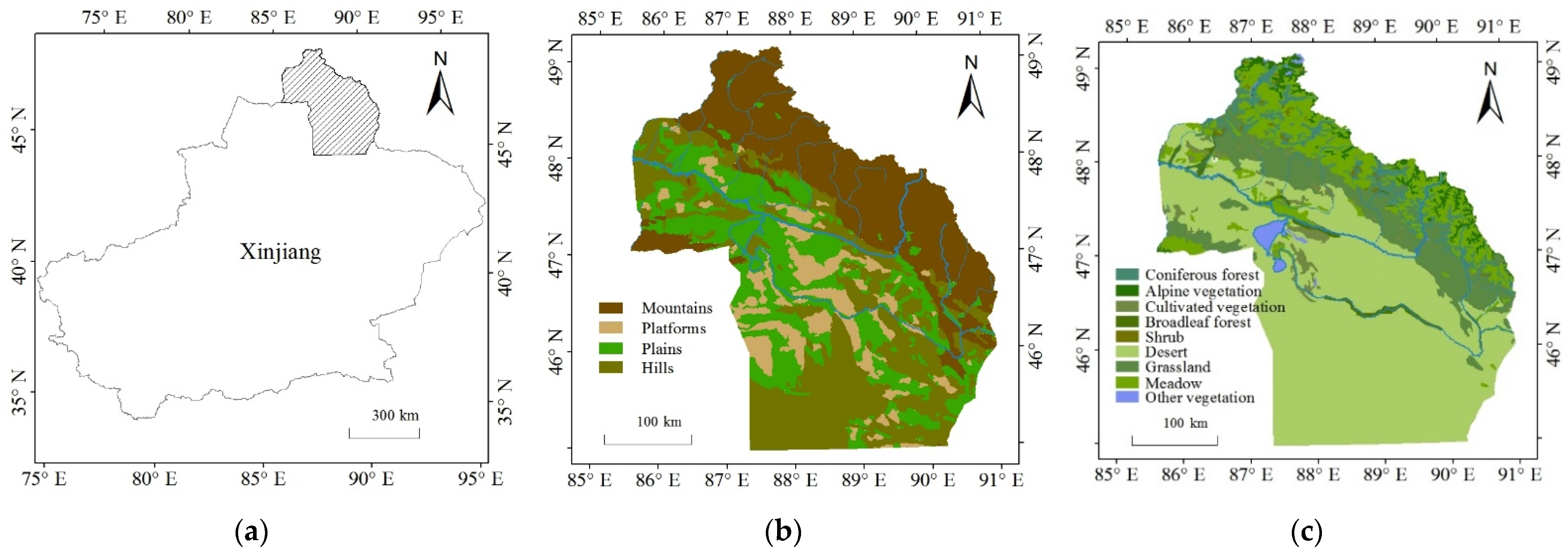
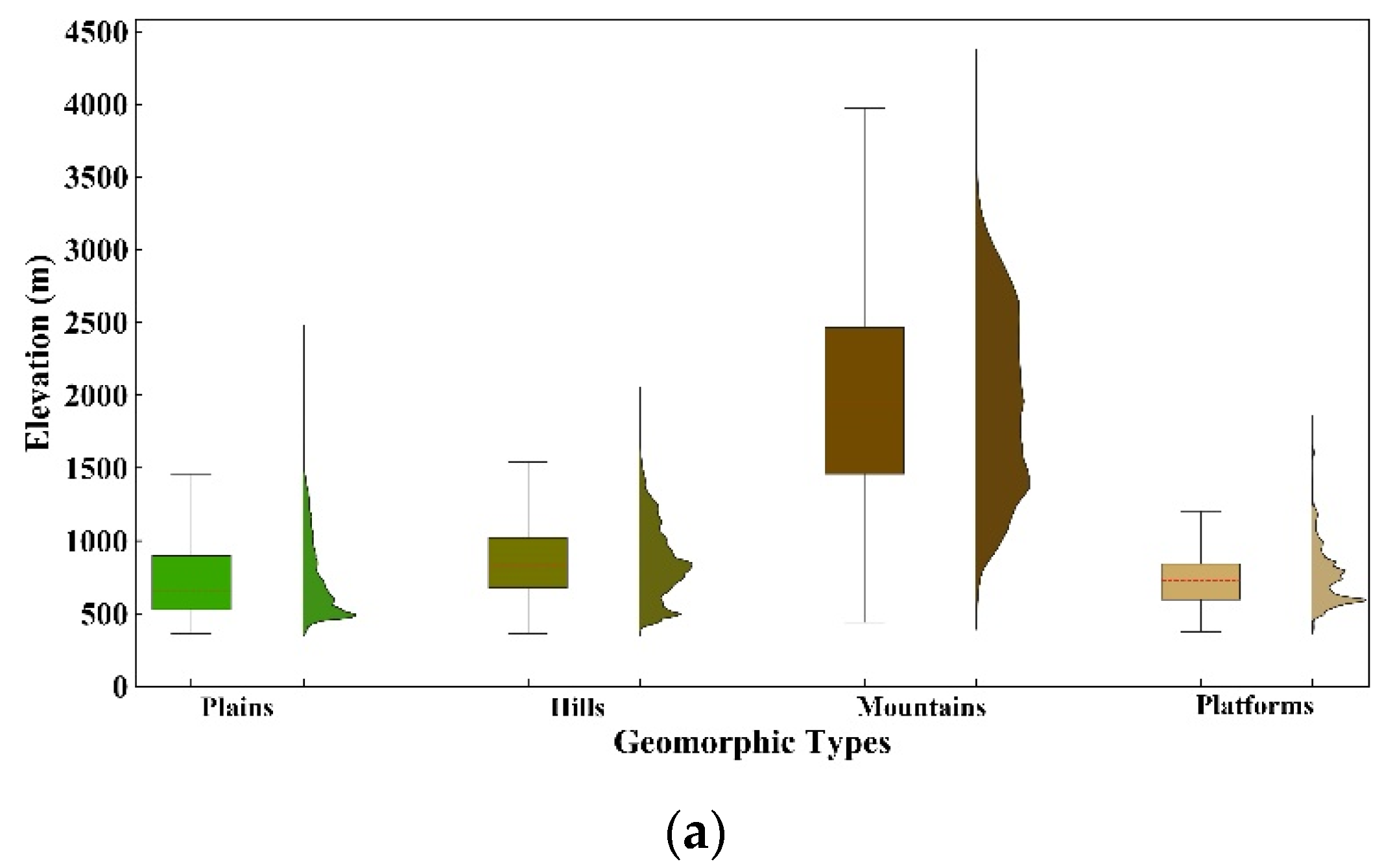
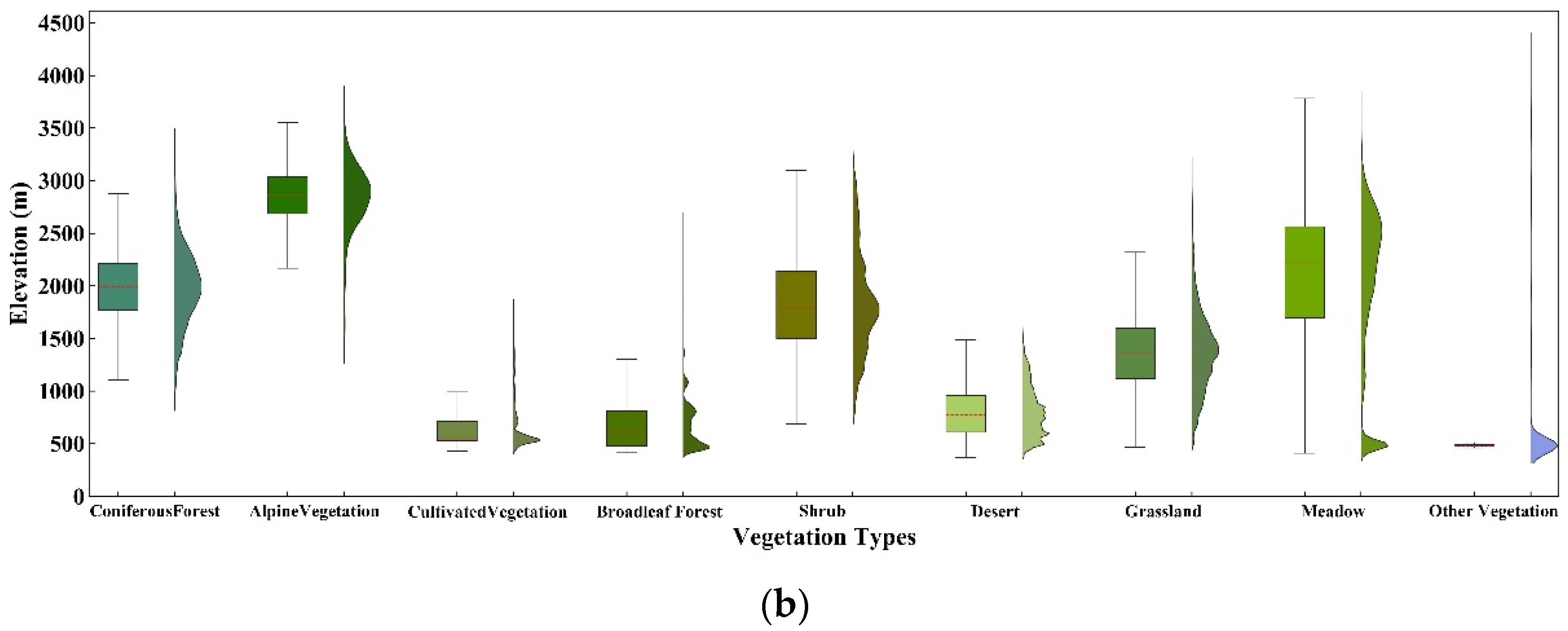
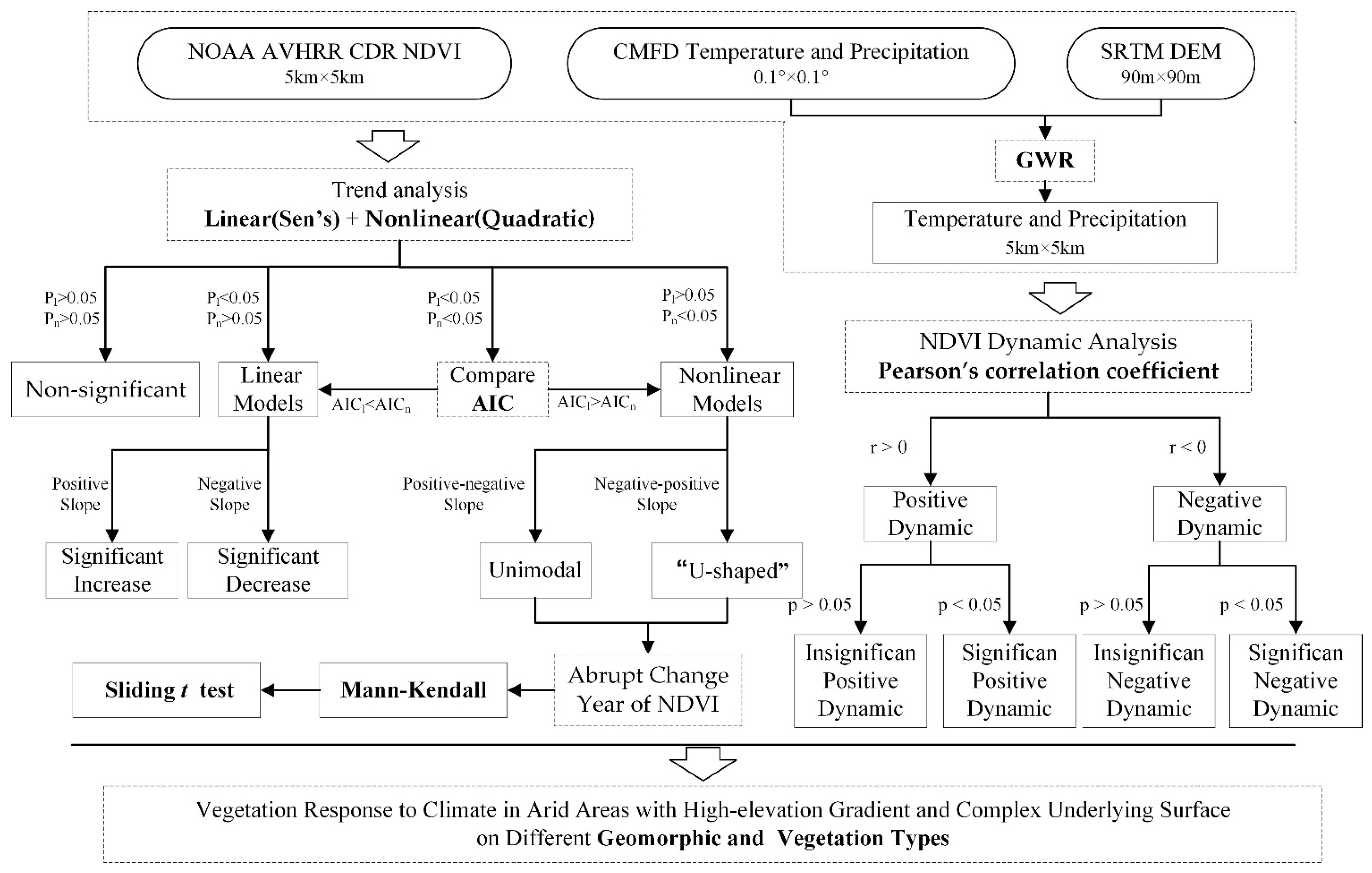
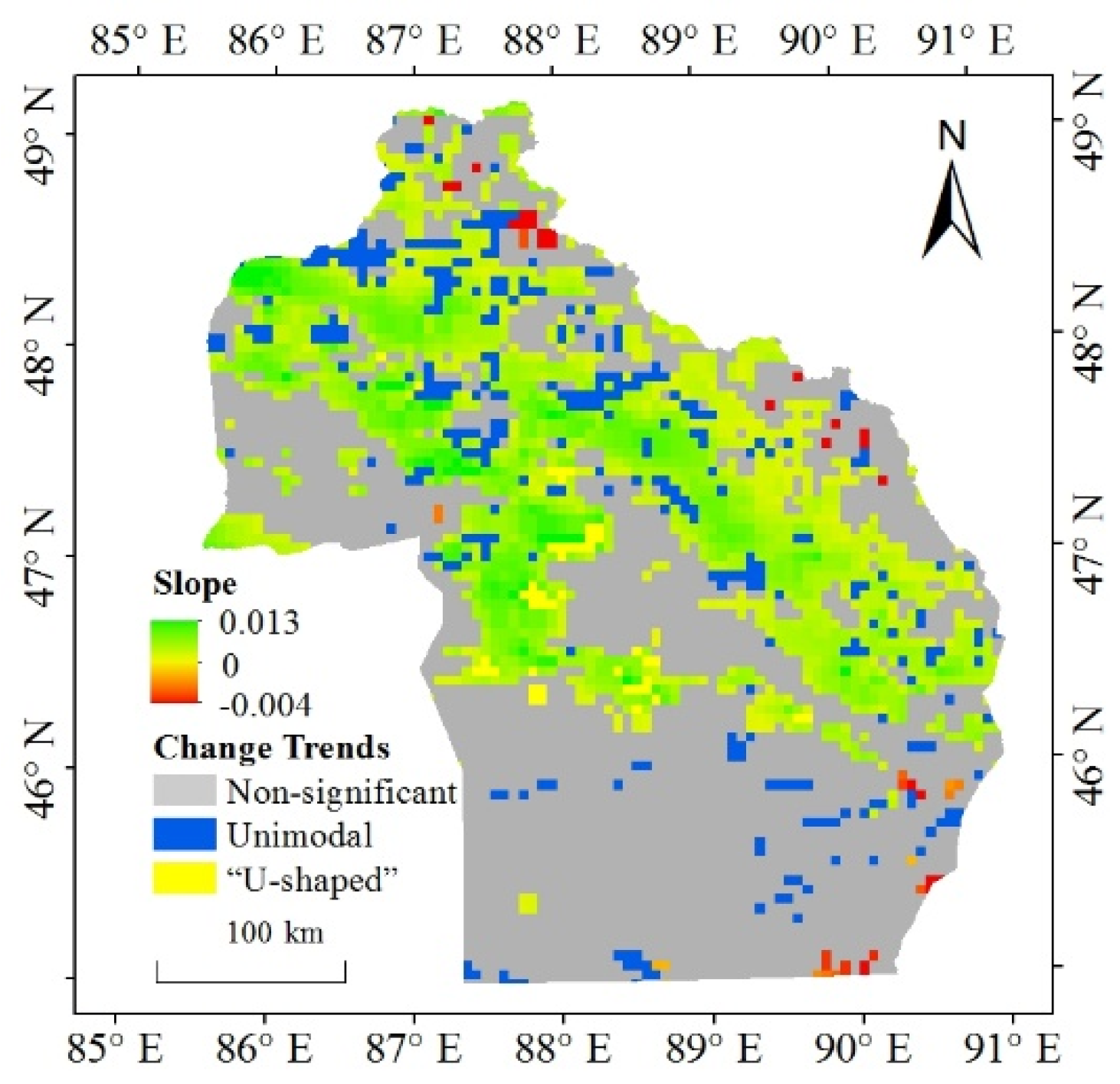
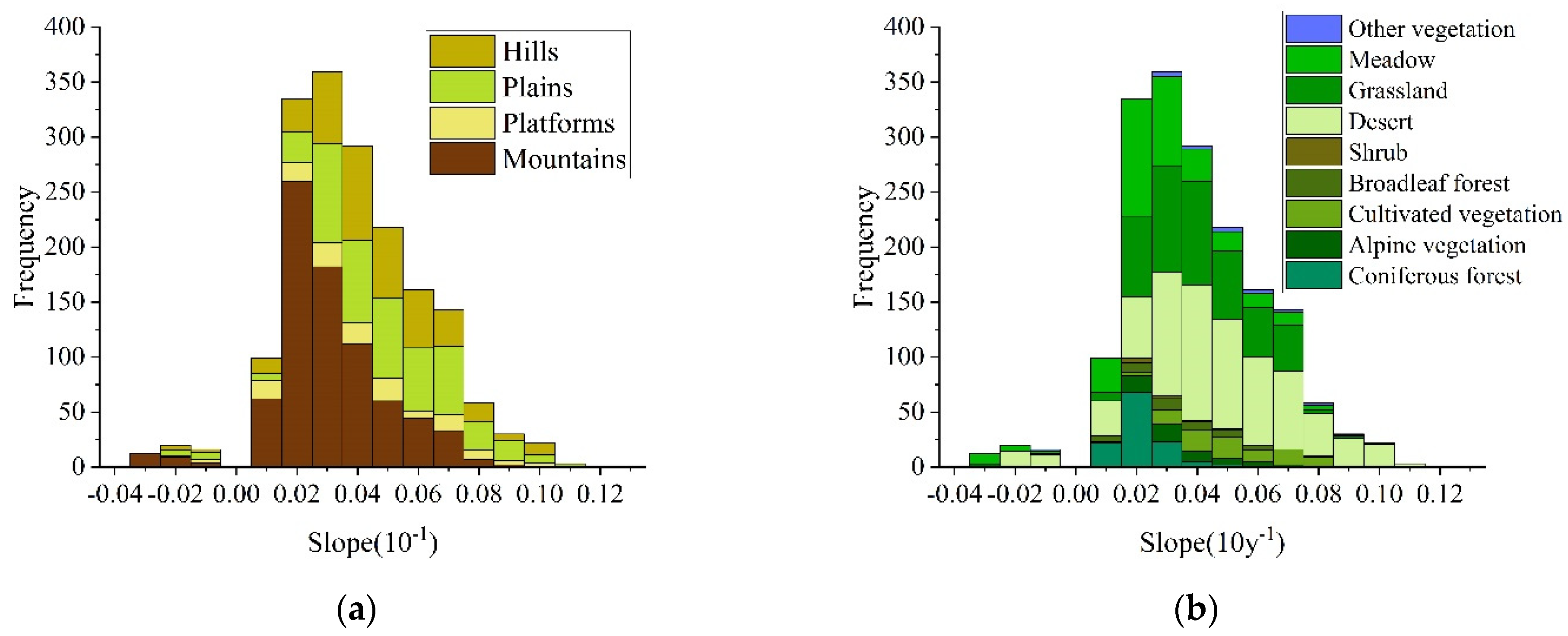
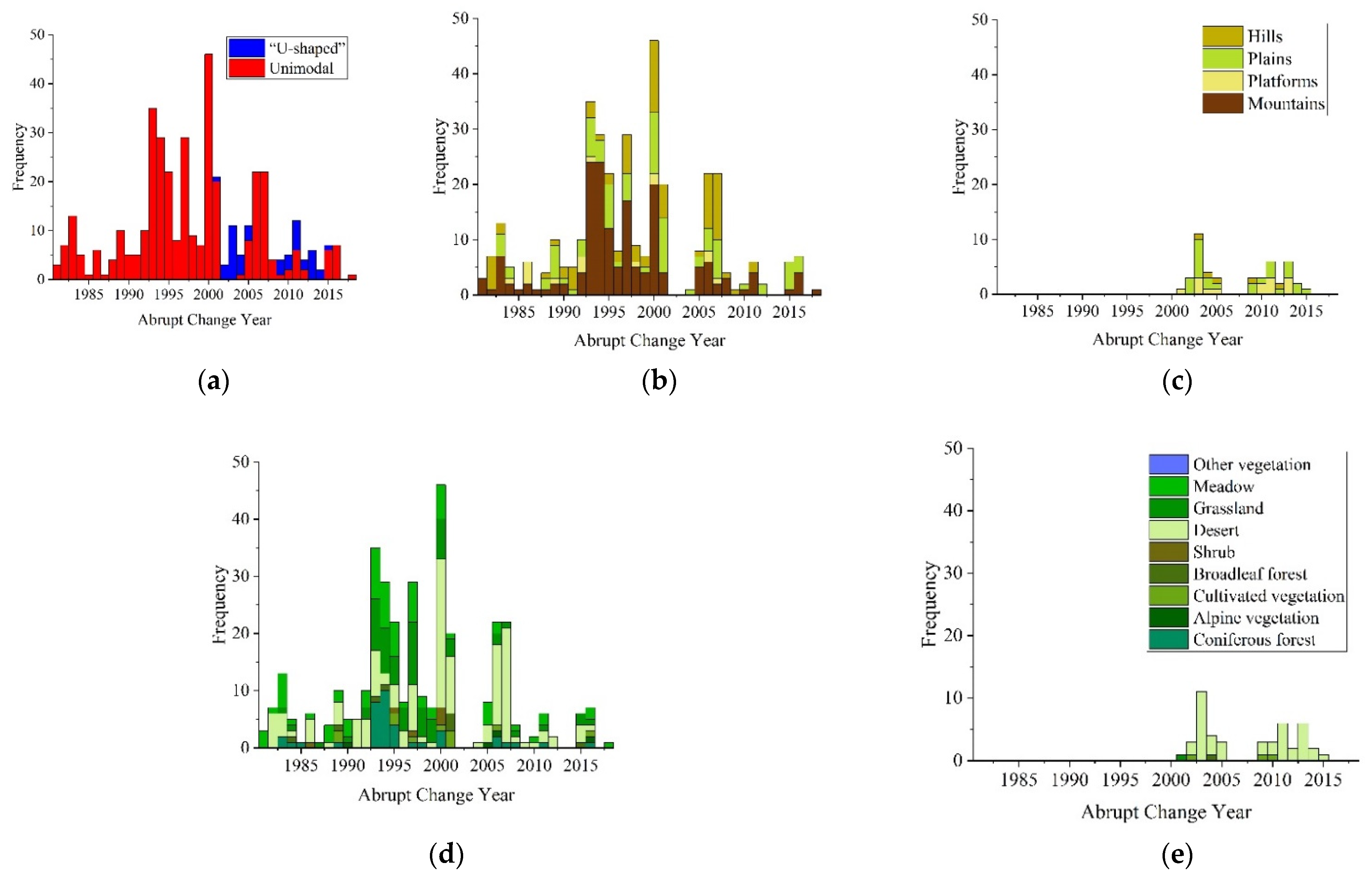
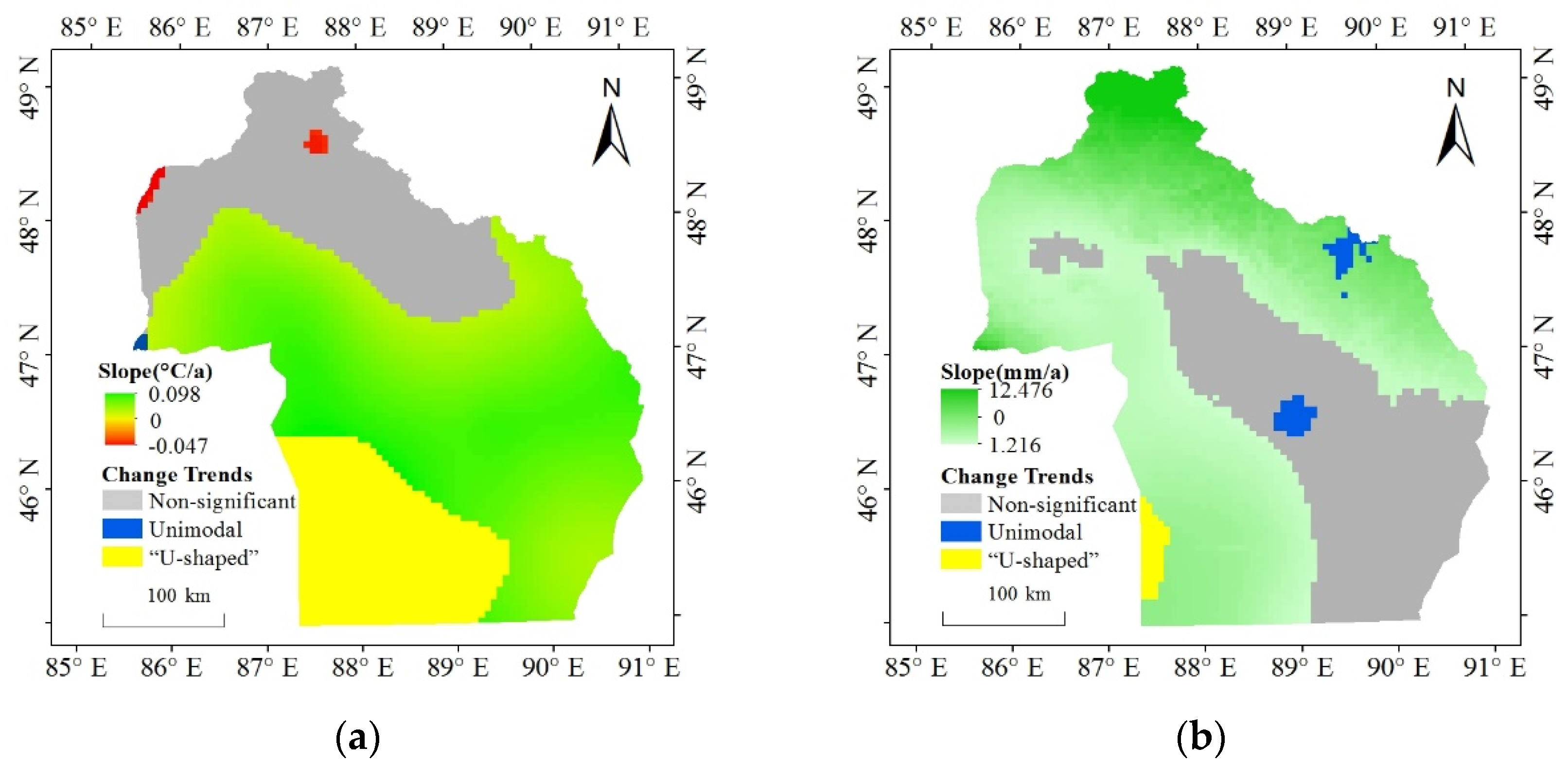

| Data Name | Data Resolution | Data Source |
|---|---|---|
| NDVI dataset | 5000 m (yearly) | National Oceanic and Atmospheric Administration (http://www.noaa.gov/web.html, accessed on 1 June 2022) |
| Climate dataset | 10,000 m (yearly) | National Data Center for Tibetan Plateau Science (http://data.tpdc.ac.cn, accessed on 27 July 2022) |
| Vegetation regionalization data | 1:1,000,000 | Cloud Platform of Resources and Environmental Data, Chinese Academy of Sciences (http://www.resdc.cn, accessed on 10 September 2022) |
| Geomorphic regionalization data | 1:1,000,000 | Cloud Platform of Resources and Environmental Data, Chinese Academy of Sciences (http://www.resdc.cn, accessed on 10 September 2022) |
| SRTM | 90 m | CGIAR Consortium for Spatial Information (http://srtm.csi.cgiar.org/, accessed on 1 June 2022) |
| Geomorphic Type | Significant Increase | Significant Decrease | Unimodal | “U-Shaped” | Non-Significant |
|---|---|---|---|---|---|
| All | 1722 (35.2%) | 50 (1.0%) | 357 (7.3%) | 45 (0.9%) | 2718 (55.6%) |
| Plains | 447 (33.8%) | 11 (0.8%) | 91 (6.8%) | 26 (1.9%) | 745 (56.4%) |
| Platforms | 135 (27.0%) | 4 (0.8%) | 16 (3.2%) | 14 (2.8%) | 330 (66.1%) |
| Hills | 378 (25.3%) | 9 (0.6%) | 82 (5.5%) | 5 (0.3%) | 1016 (68.1%) |
| Mountains | 762 (48.1%) | 26 (1.6%) | 168 (10.6%) | 0 (0.0%) | 627 (39.6%) |
| Vegetation Type | Significant Increase | Significant Decrease | Unimodal | “U-Shaped” | Non-Significant |
|---|---|---|---|---|---|
| Coniferous forest | 120 (53.0%) | 1 (0.4%) | 38 (16.8%) | 0 (0%) | 67 (29.6%) |
| Alpine vegetation | 56 (30.1%) | 4 (2.1%) | 4 (2.1%) | 0 (0%) | 122 (65.5%) |
| Cultivated vegetation | 88 (75.2%) | 0 (0%) | 11 (9.4%) | 3 (2.5%) | 15 (12.8%) |
| Broadleaf forest | 45 (55.5%) | 0 (0%) | 8 (9.8%) | 1 (1.2%) | 27 (33.3%) |
| Shrub | 8 (34.7%) | 0 (0%) | 6 (26.0%) | 0 (0%) | 9 (39.1%) |
| Desert | 662 (23.0%) | 25 (0.8%) | 142 (4.9%) | 40 (1.3%) | 2005 (69.7%) |
| Grassland | 426 (66.0%) | 1 (0.1%) | 70 (10.8%) | 1 (0.1%) | 147 (22.7%) |
| Meadow | 297 (43.3%) | 17 (2.4%) | 78 (11.3%) | 0 (0%) | 293 (42.7%) |
| Other vegetation | 20 (36.3%) | 2 (3.6%) | 0 (0%) | 0 (0%) | 33 (60.0%) |
| Climatic Factors | Significant Increase | Significant Decrease | Unimodal | “U-Shaped” | Non-Significant |
|---|---|---|---|---|---|
| Annual mean temperature | 2744 (56.0%) | 29 (0.5%) | 8 (0.1%) | 864 (17.6%) | 1247 (25.4%) |
| Total annual precipitation | 3160 (64.5%) | 0 (0%) | 66 (1.3%) | 60 (1.2%) | 1606 (32.8%) |
| Climatic Factors | Significant Positive Correlation | Significant Negative Correlation | Insignificant Positive Correlation | Insignificant Negative Correlation |
|---|---|---|---|---|
| Annual mean temperature | 368 (7.5%) | 109 (2.2%) | 2166 (44.2%) | 2249 (45.95%) |
| Total annual precipitation | 276 (5.6%) | 501 (10.2%) | 4115 (84.1%) | 0 (0%) |
| Climatic Factors | Geomorphic Type | Significant Positive Correlation | Significant Negative Correlation | Insignificant Positive Correlation | Insignificant Negative Correlation |
|---|---|---|---|---|---|
| Annual mean temperature | Plains | 175 (13.2%) | 27 (2.0%) | 614 (45.5%) | 504 (38.1%) |
| Platforms | 79 (15.8%) | 4 (0.8%) | 247 (49.4%) | 169 (33.8%) | |
| Hills | 86 (5.7%) | 51 (3.4%) | 540 (36.2%) | 813 (54.5%) | |
| Mountains | 28 (1.7%) | 27 (1.7%) | 765 (48.3%) | 763 (48.1%) | |
| Total annual precipitation | Plains | 75 (5.6%) | 107 (8.1%) | 1138 (86.2%) | 0 (0%) |
| Platforms | 29 (5.8%) | 28 (5.6%) | 442 (88.5%) | 0 (0%) | |
| Hills | 100 (6.7%) | 183 (12.2%) | 1207 (81.0%) | 0 (0%) | |
| Mountains | 72 (4.5%) | 183 (11.5%) | 1328 (83.8%) | 0 (0%) |
| Climatic Factors | Vegetation Type | Significant Positive Correlation | Significant Negative Correlation | Insignificant Positive Correlation | Insignificant Negative Correlation |
|---|---|---|---|---|---|
| Annual mean temperature | Coniferous forest | 4 (1.7%) | 9 (3.9%) | 95 (42.0%) | 118 (52.2%) |
| Alpine vegetation | 2 (1.0%) | 2 (1.0%) | 106 (56.9%) | 76 (40.8%) | |
| Cultivated vegetation | 40 (34.1%) | 0 (0%) | 54 (46.1%) | 23 (19.6%) | |
| Broadleaf forest | 23 (28.3%) | 0 (0%) | 38 (46.9%) | 20 (24.6%) | |
| Shrub | 0 (0%) | 0 (0%) | 8 (34.7%) | 15 (65.2% | |
| Desert | 252 (8.7%) | 81 (2.8%) | 1173 (40.8%) | 1368 (47.5%) | |
| Grassland | 20 (3.1%) | 3 (0.4%) | 336 (52.0%) | 286 (44.3%) | |
| Meadow | 21 (3.0%) | 14 (2.0%) | 334 (48.7%) | 316 (46.1%) | |
| Other vegetation | 6 (10.9%) | 0 (0%) | 22 (40.0%) | 27 (49.0%) | |
| Total annual precipitation | Coniferous forest | 7 (3.0%) | 10 (4.4%) | 209 (92.4%) | 0 (0%) |
| Alpine vegetation | 11 (5.9%) | 45 (24.1%) | 130 (69.8%) | 0 (0%) | |
| Cultivated vegetation | 3 (2.5%) | 1 (0.8%) | 113 (96.5%) | 0 (0%) | |
| Broadleaf forest | 9 (11.1%) | 11 (13.5%) | 61 (75.3%) | 0 (0%) | |
| Shrub | 1 (4.3%) | 1 (4.3%) | 21 (91.3%) | 0 (0%) | |
| Desert | 189 (6.5%) | 314 (10.9%) | 2371 (82.4%) | 0 (0%) | |
| Grassland | 21 (3.2%) | 17 (2.6%) | 607 (94.1%) | 0 (0%) | |
| Meadow | 34 (4.9%) | 88 (12.8%) | 563 (82.1%) | 0 (0%) | |
| Other vegetation | 1 (1.8%) | 14 (25.4%) | 40 (72.7%) | 0 (0%) |
Disclaimer/Publisher’s Note: The statements, opinions and data contained in all publications are solely those of the individual author(s) and contributor(s) and not of MDPI and/or the editor(s). MDPI and/or the editor(s) disclaim responsibility for any injury to people or property resulting from any ideas, methods, instructions or products referred to in the content. |
© 2023 by the authors. Licensee MDPI, Basel, Switzerland. This article is an open access article distributed under the terms and conditions of the Creative Commons Attribution (CC BY) license (https://creativecommons.org/licenses/by/4.0/).
Share and Cite
Yan, Y.; Cheng, J.; Li, Y.; Fan, J.; Wu, H. Characteristics of NDVI Changes in the Altay Region from 1981 to 2018 and Their Relationship to Climatic Factors. Land 2023, 12, 564. https://doi.org/10.3390/land12030564
Yan Y, Cheng J, Li Y, Fan J, Wu H. Characteristics of NDVI Changes in the Altay Region from 1981 to 2018 and Their Relationship to Climatic Factors. Land. 2023; 12(3):564. https://doi.org/10.3390/land12030564
Chicago/Turabian StyleYan, Yang, Junhui Cheng, Yongkang Li, Jie Fan, and Hongqi Wu. 2023. "Characteristics of NDVI Changes in the Altay Region from 1981 to 2018 and Their Relationship to Climatic Factors" Land 12, no. 3: 564. https://doi.org/10.3390/land12030564
APA StyleYan, Y., Cheng, J., Li, Y., Fan, J., & Wu, H. (2023). Characteristics of NDVI Changes in the Altay Region from 1981 to 2018 and Their Relationship to Climatic Factors. Land, 12(3), 564. https://doi.org/10.3390/land12030564





